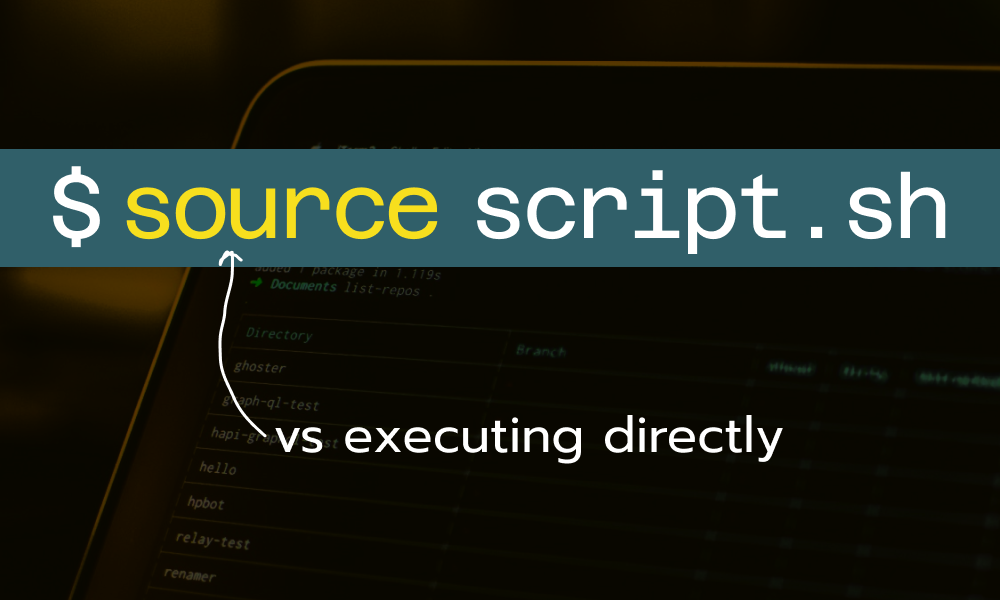Sourcing vs Executing Script Directly
March 5th, 2024

You can execute a shell script (written in bash) in multiple ways; either by executing the script directly or executing the script with the source command. But what's the difference and when should you use which? 🤔
Let's say you have this simple bash script:
myScript.sh#!/bin/bashNAME="deeecode"str="My name is $NAME"echo "$str"
First, let's make the file executable:
chmod +x ./myScript.sh
Now, you can execute this script directly in the terminal like this:
./myScript.sh# My name is deeecode
Or you can use the source command:
source ./myScript.sh# My name is deeecode
Both methods work fine, but here's where the difference comes in.
Directly vs source
In myScript.sh, we have a variable called NAME. When we execute the script directly in the terminal, let's say we try to access the NAME variable:
./myScript.sh# My name is deeecodeecho $NAME#
Well, we get an empty string. That's because, the NAME variable is not available outside the executed script. I'll explain why in a second.
Let's now try to execute the script with source, and access the NAME variable afterwards:
source ./myScript.sh# My name is deeecodeecho $NAME# deeecode
Well here, the NAME variable is available even after the script is executed. Now, let's see why.
Main process and Subprocesses
When you execute a script directly (like we did with ./myScript.sh), you are creating a subprocess from the main process. After the script finishes execution, the subprocess is closed, which means every variable created, such as NAME, becomes unavailable:
# run command in main process./myScript.sh# --subprocess opens--# code runs, NAME variable created# NAME variable is accessible# command is done running# --subprocess closes--# NAME no longer available in main process
But when you use source, you are executing the myScript.sh script in the main process. So, every variable, like NAME is added to the main process. Even after the script finishes execution, as long as the main process stays open, NAME and any other variables declared stays available:
# run command in main processsource ./myScript.sh# --still in main process--# code runs, NAME variable created# NAME variable is accessible# command is done running# --still in main process--# NAME is available in main process
But when you close your terminal (or that process), then those variables become unavailable.
Variables and Functions
We have seen so far how variables stay available in the main process when you use source. The same concept applies to functions. Let's see an example:
myScript.sh#!/bin/bashprint_info () {name=$1country=$2echo "$name lives in $country"}print_info Deeecode Brazil
Now, let's execute directly on the terminal:
./myScript.sh# Deeecode lives in Brazil
Remember, a new subprocess was created for this, and closed after execution. So if we try to acess print_info now, watch what happens:
print_info John China# command not found: print_info
Now we get an error. print_info was only available in the subprocess, and the subprocess is no longer available.
Now, let's use source:
source ./myScript.sh# Deeecode lives in Brazil
Works fine when we execute the script. Now, let's try to access print_info in the terminal:
print_info John China# John lives in China
As you see here, print_info is available in the main process...why? Because by using source, a new subprocess is not created for ./myScript.sh. The script is run directly in the main process, thereby exposing variables and functions like print_info to the main process.
But also remember, when the main process is closed, everything exposed with source becomes unavailable.
Wrap up
I hope the difference is clearer now. Executing a script directly creates a subprocess which closes after the script is done. But with source, you're able to expose variables and functions from those configuration files, so that you can use them in the main process.
Depending on your use case, you might prefer one approach better than the other.
If you've used process configuration files like .bashrc or .zshrc before, you'd notice that often times you're instructed to do source .bashrc when you make changes. Maybe now you understand why?
If you don't, I explain it in this article.
